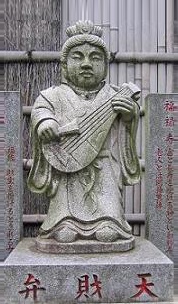Benzaiten is one of the deities (fukunokami) of the Seven Lucky Gods of Japan (Shichifukujin); the other six being:

Benzaiten was an angel of one of the Tridevi Hindu goddesses, Sarasvati - the other two being Lakshmi and Parvati. She is also revered in Jainism, Buddhism and Shintoism.
Sarasvati's fine arts include music, painting, sculpture, dance and literature. Although Sarasvati is a Hindu goddess, Benzaiten came to Japan with Buddhism during the 6-8th centuries.
In addition to inheriting Sarasvati attributes, Benzaiten's syncretization with Shinto led to an association with war, dragons and snakes, prosperity and fortune, and protection from disease and disaster. Her virtues also include happiness and longevity.
Buddhist temples and Shinto shrines honouring Benzaiten are commonly near rivers or ponds, due to her association with water. She is the only female deity among the Shichifukujin and depictions can show her calmly sitting or standing on a lotus leaf, or riding a white dragon, sea serpent or snake. There are many statues of Benzaiten on Enoshima, a small island off the Shōnan coast of Japan’s Kanagawa Prefecture.
A legend of the island's creation was written by Kokei (977 – 1049 AD), a Buddhist monk of the Tendai sect. The story is about the residents of a coastal fishing village in the 6th century who were troubled for a thousand years by a five-headed dragon that emerged from a swamp.
Benzaiten acknowledged that a five-headed dragon would indeed be troubling, so she pulled the land where the village was situated away from the mainland, thereby creating the island. The townsfolk then lived on the island in safety.
The story continues that when the dragon saw how beautiful Benzaiten was, he fell in love with her and asked for her hand in marriage. Benzaiten rejected the proposal and the dragon, heartbroken, has forever since remained on the mainland, facing the island, watching and hoping that one day Benzaiten will change her mind.
Today there's a bridge to the island (Enoshima Benten Bridge) which the dragon would be able to use, but sadly, long before the bridge was built, the dragon petrified into a hill known today as Tatsunokuchiyama (Dragon’s mouth hill’).
Benzaiten’s role as goddess of warriors was confirmed in the 12th century by Minamoto Yoritomo who founded the bakufu (shogunate), a system whereby feudal lords ruled Japan for 700 years. He sought her divine assistance to successfully defeat the Fujiwara clan.
And yet, her softer persona has prevailed. Ancient images and figurines of her with eight arms, wielding a sword, trident and other weapons of war, have become less common than her holding, or sometimes playing, a lute (biwa).
This traditional fish-shaped instrument is seldom used for solo performance; rather as a 'narrative instrument' providing background when relating a story or sutra. Its twisted silk strings are plucked with a bachi (wedge-shaped plectrum) at various speeds, intensities and volumes for emphasis.
As with all paintings and statues, the pose and adornments depend on the message that the temple, shrine or other host wishes to portray.
Use the is gender-neutral "patron" if you prefer.
The seven notes of a chromatic musical scale are believed to have been created by Sarasvati.
Or, if you prefer, Fra Guido d'Arezzo, a Benedictine monk born around 992.
The site was later used for executions.